My title avoided the word “ultralight” even if these two aircraft qualify. The American entry can readily fit FAA’s Part 103 as an Ultralight Vehicle, freeing the pilot from having to register the aircraft, or have a pilot certificate, or possess any sort of “medical” to fly it.
The French entry cannot qualify as a Part 103 but I find it surprising this super lightweight machine is a two seater and can be electric-powered. It is not available in the USA at this time but the brand once had a strong American presence. I owned one of their light trikes myself a couple decades back. Here’s a full review from 2004.
Welcome to brief reviews of two very light weight-shift aircraft, North Wing’s SkyMax and La Mouette’s Samson. (La Mouette is French for seagull.)
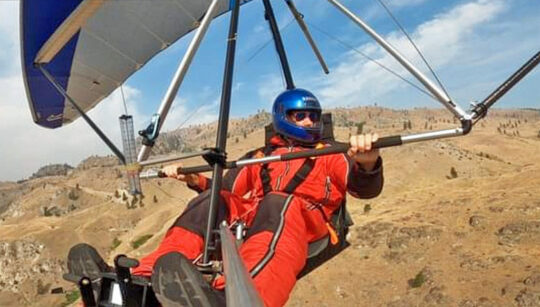
SkyMax seen with aft gear retracted out of the wind. photo courtesy North Wing
That these two are also more affordable may come to the rescue of budgets under assault by persistent inflation.
Here’s a brief look at both models with links to more detailed information on each.
North Wing
SkyMax
A regular in the light trike space, Washington State’s North Wing recently introduced their new SkyMax Nanolight Soaring Trike. The longtime producer also offers fully FAA-accepted LSA models (full line review), featuring robust frames and two comfortable seats. Yet since starting his enterprise to build hang gliding wings, company founder Kamron Blevins has never lost sight of the soaring potential for extremely low-weight trike carriages, for example Solairus (video review). If you live where no mountains exist, these machines provide a way into the sky …and they won’t break your budget.
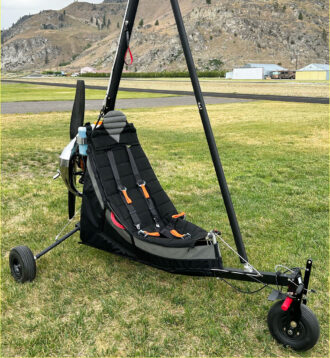
“This very light trike uses a unique combination of components that keep the SkyMax strong and durable,” said North Wing, “yet SkyMax is very light weight, which makes for great soaring performance. You can easily attach this trike to your hang glider, and the trike and engine quickly folds down to a very convenient size that is very portable and easy to transport.”
SkyMax is built with aircraft aluminum construction and aircraft hardware. Rear landing gear is pultruded fiberglass and steel. The mast (on which the wing is mounted) and forward limit tube are airfoil-shaped aluminum. Main gear tires are 10 inches allowing touchdown on unimproved areas, and the front tire uses a friction brake.
“After take-off and safe climb, the rear landing gear can be retracted by stepping on the left-pedal to release a gear-lock and then pulling the retract cord to raise the gear and reduce your drag profile for better performance. This is easily seen in a video found using the link below.
SkyMax has a 1.5 gallon fuel tank, powering your flight for 1.5 to 2 hours. With engines ranging from 22 to 27 horsepower, fuel usage is miserly. Fortunately the cost to purchase is also very reasonable.
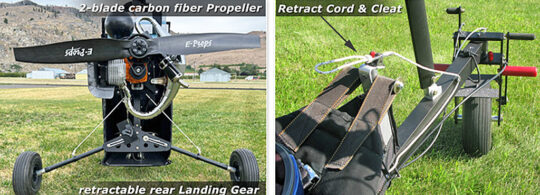
Explore this affordable aircraft further on North Wing’s dedicated SkyMax web page. This page contains several video clips, lots more detailed images with descriptions, plus engine choices and options. Find all that North Wing offers.
La Mouette
Samson
Electric or Gas
“Samson started an electric adventure,” stated an equally longtime French producer La Mouette. “As we were the first to manufacture a motorized aircraft propelled solely with hydrogen, and builder of the first two-seater electric trike, La Mouette definitely has an edge on electrical technology.”
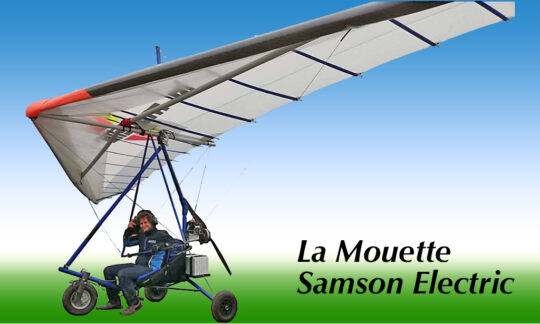
“At La Mouette, we’ve decided to wait for the hydrogen supply chain to mature before offering this technology to interested parties. In the meantime, due to proven battery technology, there are different solutions guided by the right balance of autonomy, weight, cost, and power.”
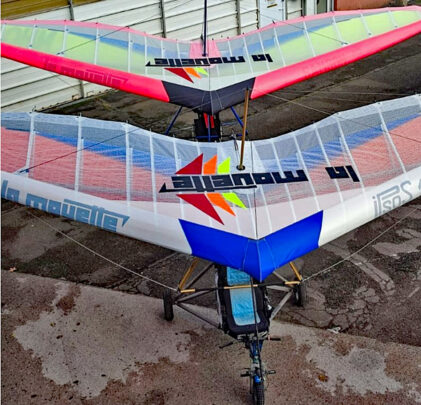
50 kilowatts.” (For reference, 1 kilowatt = 1.34 horsepower.) “For the same takeoff weight, every one of these engines will consume approximately the same amount of energy. Thus, a 12 kilowatt engine propelling a 190 kilogram (419 pound) Samson will consume as much energy as a 32 kilowatt engine propelling the same weight Samson. On the other hand if the pilot suddenly needs more energy, the 12 kilowatt engine would be limited to that 16 horsepower, whereas a 32 kilowatt motor (43 horsepower) could provide more thrust though it will consume more stored energy.”
“The Lithium-Ion batteries that we currently use to power the motors come in 15.5 kilogram (34 pound) packs,” La Mouette explained. “A Samson trike mounted on a 12-square-meter (128 square foot) flex wing can fly about two minutes per kilogram of battery on a single-seater and one minute per kilogram of battery weight when flown as a two-seater. A battery pack will therefore be able to fly a Samson weighing 419 pounds for 30 minutes while cruising, or 15 minutes at 595 pounds engine flying at full speed. For more powerful engines it is necessary to put more batteries to exploit the motor’s full power, although this is offset by having to carry the greater battery weight.
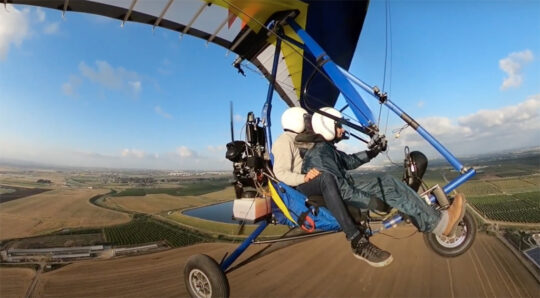
A 20 kilowatt motor for an occasional tandem flight needs a minimum of three high-discharge batteries or four high-density batteries.
Fifteen years ago, I wrote about company founder Gerard Thevenot building the first hydrogen fuel-cell-equipped trike. This company that could once claim to be the largest producer of hang gliders has literally decades of experience creating electric trikes.
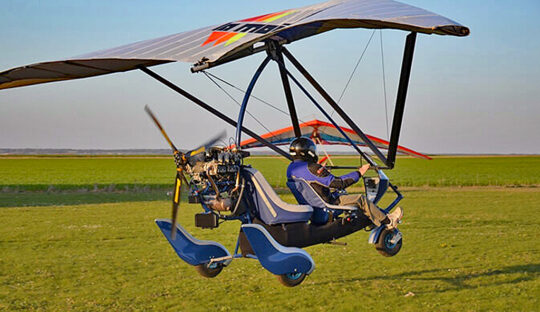
I am not reporting price for the Samson as no U.S. supplier is specified yet. If interested, contact the company using email.
Find the full data sheet on Samson Electric from La Mouette.
I know both these companies for many years and have visited their factories. Each is a reliable supplier of aircraft.
So, why are you waiting get in the air?


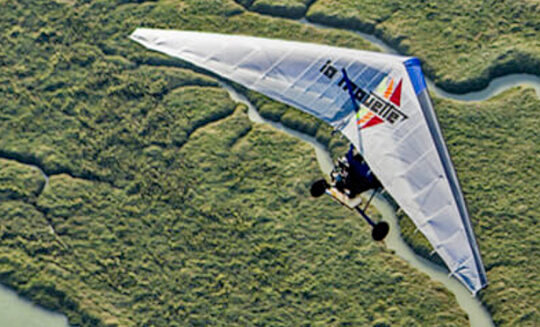
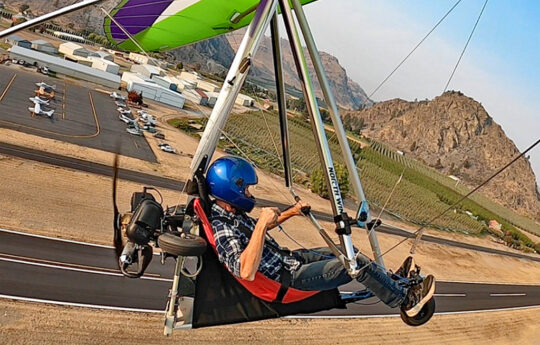
I know part 103 trikes are easy to fly, but still require instruction. Where does one find a list of instructors for people who specifically want to learn how to fly a small part 103 trike? Thanks.
Two choices: one should already have taken flying lessons to know how to handle a trike. 2. The trike manufacturer should have provided an operators handbook with the trike showing how to fly it and the relevant flying numbers: Vy; Vx; Vne; and a list of wear items and when to replace. The manufacturer usually assumes you have no flying experience and provides a flying sequence of events to follow in order: low speed taxi, high speed taxi, take off staying in ground effect; shallow S turns above the runway, steeper S turns above the runway. Each done 3 to 6 times or more until comfortable with the craft. Only then a full pattern flight. And then where ever you want to go. Flying with the geese is probably the most exhilarating; if you can find them.
One needs to check on line or call Flight Service to insure you are not flying into a temporary flight restricted area TFR. Or a permanent flight restricted area shown on a sectional chart near your location. Always keep the sectional chart with you for the location you are flying in; in case the sheriff shows up and wants to know what you are doing. Rare, but has happened.
I had a Rogallo wing kite with a friend at age 19. I built a tripod with a chair with controls to sit instead of hanging on a bar. We towed it with a snowmobile on the lake during winter wearing snowmobile winter suits. My preference now is for a Jetson 1. Flying part time over the last 53 years and with near 1000 hours in small fixed wing aircraft; going to an airport is not something I do not want to continue to do. I am waiting on the US Justice Department to explain the US Commerce Clause of the US Constitution and the 200 plus years of case law to the FAA that no one can obstruct commerce. Because an FAA bureaucrat said no to me about a year back landing and taking off from my driveway; evidently without checking with legal counsel. Any help you can provide would not only be appreciated by me, but all Jetson 1 and Pivotal Helix potential operators. Plus, the future likely holds a Jetson 1 with one hour plus of endurance with an aircraft radio and a transponder allowing it to be a commute aircraft greatly relieving metro traffic jams. The Jetson 1 has triple software that checks each other that flies the craft. The operator only moves the controls to tell the software where to go. Plus, LIDAR for avoiding obstructions. Plus a ballistic parachute in case more than one propeller fails. The Jetson 1 is safer than any other aircraft and way, way safer than any auto; plus the with is less than 10 feet making it street legal. And the FAA needs to acknowledge all of this allowing takeoffs and landings from private urban driveways and public parking lots.
La Mouette does have a US distributor:
Blue Collar Aviation
12 Main St #1
Maynard, MA 01754
(978) 273-7460
Thanks, Tabor!
For lots more about what Blue Collar Aviation has to offer, see this article from January 2024.
La Mouette presence in the United States is in progress, they do have a professionnal training user instructor in the Massachusetts.
Hi Dan,
Just a note, the two place fits within the ASC Exemption 9785.
ASC
Jim Stephenson
269-209-1466